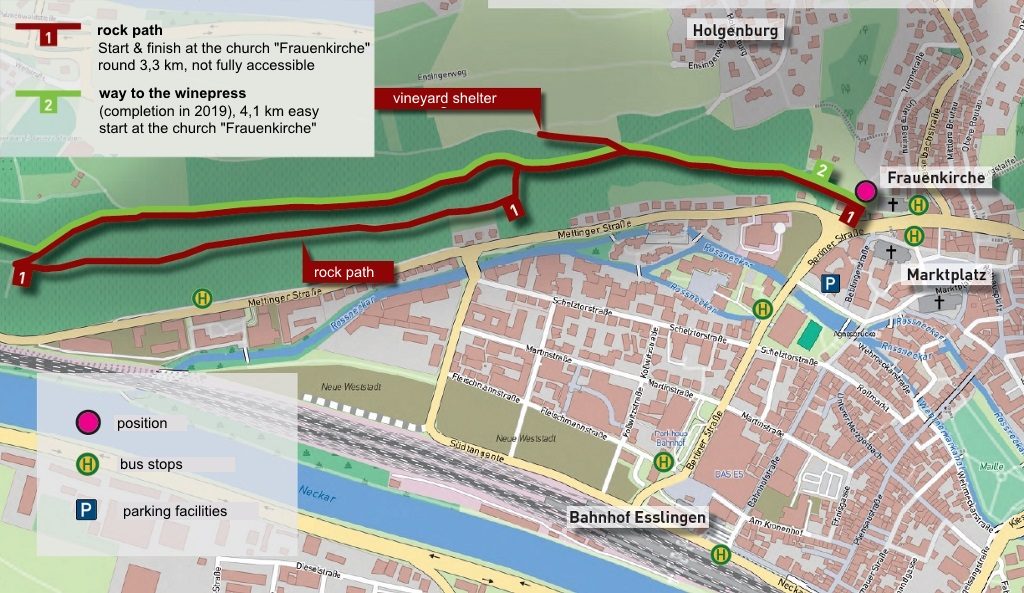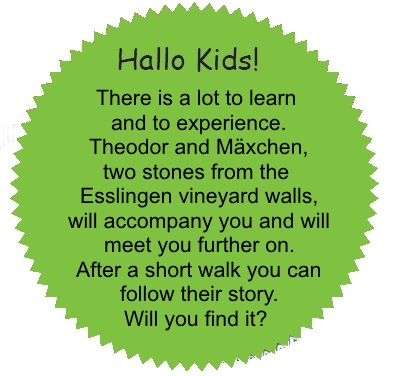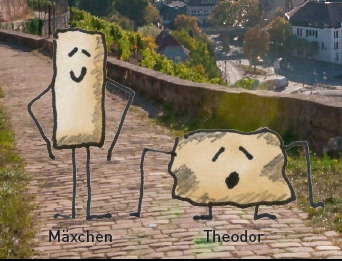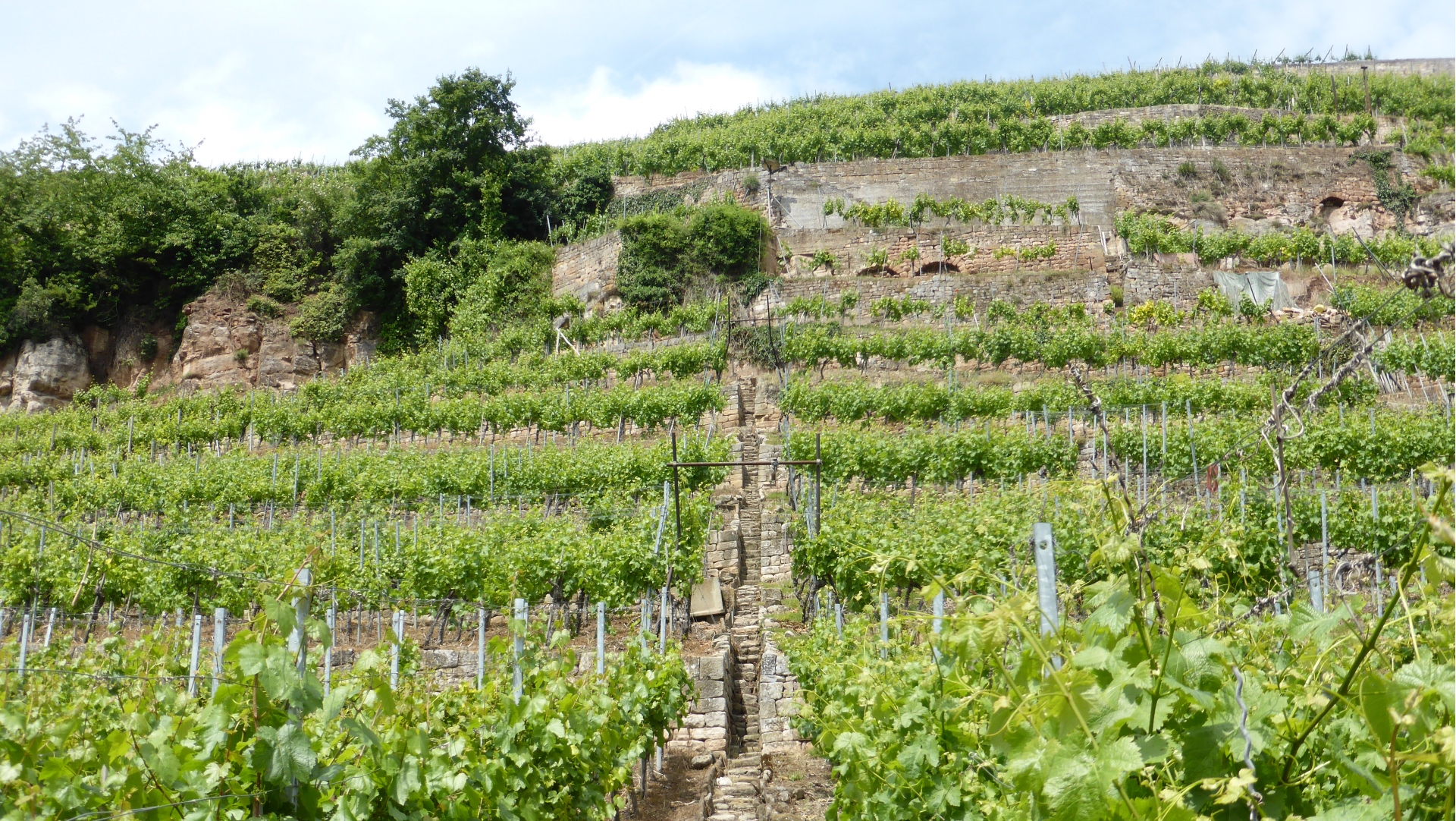Erlebt ES
Home » Erlebt ES


What can you await?
Experience the historic terraced vineyards in Esslingen. This trail takes you into a unique cultural landscape. It offers you exciting insights into the history and cultivation of the Esslingen wine, the work of the winegrowers and the peculiarities of nature and geology. And, there are fantastic views on the Neckar valley and the medieval district.
What do you have to bring?
To experience the steep slopes you should have solid footwear, a head for heights, agility, you should bring along time and hiking energy. Then the walk is also good for children and elderly people.
What else should you pay attention to?
The trail will also lead you through narrow vineyard slopes and past steep wall crashes. Please note that you walk on your own risk. Take care of your children, especially when the path leads past precipices.

How can you get more information?
There are many boards with additional information you can get using the QR-codes or alternatively the mentioned internet address. The used symbols (eye, ear) tell you what kind of additional information it is. (pictures, texts or audio) At different positions you can hear wine growers and other experts reporting about interesting topics related to viniculture. In order to read the QR-Codes you will need a smartphone or a QR-reader software. If you haven’t installed it yet, there are QR-Reader in the appstore (Apple) or at Google Play (Android) available free of charge.


Thematic area 1: The history of the Esslingen wine

Station 1a
Welcome!
Otto Rapp, Chairman of the social club “Staffelsteiger” welcomes you and reports about the involvement of the club members for this trail “Esslinger Weinerlebnisweg”. more …


Station 1b
Esslingen and the wine
Dr. Joachim Halbekann, head of the city archive, explains the outstanding importance of viticulture for the city Esslingen and clarifies the function of the “Pleghöfe”. more …

Station 2a
Winepresses in Esslingen
According to the great importance of the viticulture for the urban economy there were numerous wine presses in Esslingen . more …
This board was supported by the Wuerttemberg Wine Gardening Registered Cooperative (Wuerttembergische Weingärtner-Zentralgenossenschaft e.G.)

Station 2b
City fortification
A city wall was typical for medieval cities. The fortification around the city centre of Esslingen dates to the early 13th century . more …
This board was supported by the Foundation of District Savings Bank (Kreissparkasse Esslingen-Nuertingen).

Station 3
Resting bench – called “Gruhbank”
Moaning and groaning because it is so steep here! Although I only have a snack in my rucksack I feel knackered.
This board was supported by Monika und Andreas Franke, Dr. med. Kerstin Henning & Otto Fuksik, Sieglinde Linke, Claudia und Joerg Schmidt, Joachim Zinz

Station 4
Machine factory Esslingen
Situation on the river Neckar favored industrialisation in Esslingen, as water power was necessary for industrial production of the 19th century more …
This board was supported by Southwest Metal District Group Neckar-Fils (SUEDWESTMETALL, Bezirksgruppe Neckar-Fils)

Station 5a
The “Pfleghoefe” and the wine
There were lots of spiritual institutions in the medieval city of Esslingen. Besides the Parish church, its chapels and six mendicant monsteries there were lots of important locations of trade and administration, the so called „Pfleghoefe“ – they belonged to the Cathedral Chapter of Speyer and Konstanz but also to monasteries like Salem, Sankt Blasien, Bebenhausen and Denkendorf. more …
This board was supported by the Engineering Office pbs Ingenieure GmbH – climate – water – energy
Thematic area 2: Viticulture and nature in the steep slopes of Esslingen

Station 6a
The winegrowers‘ shelter
You hear the winegrowers, who cultivate the Neckarhalde in a long tradition. more …
This board was supported by the Foundation of District Savings Bank (Kreissparkasse Esslingen-Nuertingen)

Station 6b
The protector called “Wengertschuetz”
What does the man with the gun do in the vineyard?
This board was supported by the grandsons and granddaughters of Karl Gottlob Haug, winegrower, 1890-1967

Station 6c
Work to do in the vineyard
The work to be done in a ready prepared vineyard during the year.
This board was supported by steel and metal construction HEINDEL GmbH

Station 7a

The only mountain railway in Esslingen
The monorack railway makes the vintage much easier, because it can handle up to 250 kg of grapes at once. more …
This board was supported by Glazier# Workshop Glas Rapp

Station 7b

Vitalized museum steep slope viticulture
There is not much room for machines in the historic steep slope viticulture. There are modern tools, but in principle the work process has not been changed for hundreds of years.
This board was supported by Margit & Sieghilde Rapp

Station 8
Water resources of the lower Neckarhalde
Sufficient water supply is an important pre-condition for the development of cities. In the past Esslingen among others benefited from the many sources at the Neckarhalde.
This board was supported by Municipal Utilities Esslingen (Stadtwerke Esslingen GmbH & Co. KG (SWE))

Station 9
Plant protection in the vineyard
Biotrick: The confusion with the Europe grape berry moth
This board was supported by LANFX Tim Hägele IT-Services

Station 10

Fishbone design and water falls – viticulture in the steep slopes and landscape
The image of the city and the landscape around Esslingen are very much affected by the terraced vineyards.
This board was supported by NUERK Tiles and NÜUEK BRIDGECENTER (NUERK FLIESEN + BRÜCKENCENTER)

Station 11

Rocks – about walls and clean rooms
Dr. Andreas Lehmann, expert for pedology explains the geological nature of the Neckarhalde as basis for viticulture more …
The social association Staffelsteiger-Verein e.V. received the cultural landscape prize 2016 of the Swabian Homeland and the Savings Bank Association Baden-Wuerttemberg

Station 12
Cultural monument vineyard
Historical terraces can be cultural monuments for different reasons. The type and shape, the extent and the diversity of the terraces and the stairs play an important role.
This board was supported by the State Office for preservation of Monuments in the Government Presidium Stuttgart

Station 13
Dry walls
First of all dry walls have two main functions: They have to block the pressure of the hillside and second they have to divert the rain water down to the valley via the stairs, called waterfalls. more part 1 … Claus Haegele explains the whole system with its special features more part 2 …
This board was supported by the Margarete Mueller-Bull-Foundation

Station 14
Have a look at the hill of the Neckarhalde
The fertile soil of the Neckar Valley used for agricultural purposes, consist of relatively young, quaternary sediments (colourful marlite).
This board was supported by Southwest metal District Group Neckar Fils (SUEDWESTMETALL, Bezirksgruppe Neckar-Fils)

Station 15

The winegrowers have a break
It is quite tight in the cavity! Just imagine that the winegrowers at all weathers spent the whole day in the vineyard and so the refuge were very important for them.
This board was supported by the WOLFF & MUELLER GROUP

Station 16

Animals and plants in the vineyard
Here you will learn interesting facts about animals and plants that have adapted to this habitat. more …
This board was supported by Schoell Rolladen GmbH


There is more about the animals and plants that you can discover here with a little luck more … .
This board was supported by Volksbank Esslingen

Station 16c
Wine and vegetable from a single source
On the hillside of the Neckarhalde grows excellent wine – on the fertile soil of the Neckar valley fresh and wholsesome vegetable. There are some family businesses who keep old traditions of combined fruit, vegetable and wine cultivation and offer a wide range of fresh food from a single source.
This board was supported by Andreas und Petra Rapp, Weilerhofladen
Thematic area 3: Enjoy Wine from Esslingen

Station 18a

The wine year – Spring – Summer – Autumn – Winter
When the first strong sunrays flood the vineyard in spring, the wine gets a warm heart and starts to grow what all one’s worth! The wine loves the summer and grows fiercely towards the warm sunrays

The ripened grapes will be cut, put into buckets or wine buttes and then transported to the wine press.
All the years I thought that the vineyard hibernates and the winegrowers laze around at the beach.
This board was supported by DESIGN 4 EYES, Prof. B. Schmid + partners


Station 18b

Villa Weisseck and sparkling wine of Esslingen
The Swabian Mercury of 04th October 1851 reports about a new building at Gayernweg 65: “Our attractive region has got a new jewel (…) the cottage got the name Weisseck due to the position and the erector.”
This board was supported by Jeweler Lepple

Station 19
Good appetite in Zwieblingen!
Why are the citiziens of Esslingen called onions? Two of the local specialties: “Zwiebelkuchen” (onion cake) and “Sauser” (pressed grape juice which just started to ferment) more …
This board was supported by the Wine Gardening Registered Cooperative (Weingaertner Esslingen e. G.)

Station 20

After work
Have a glass of local wine after your walking tour with many interesting information and impressions. more …
This board was supported by Gaby und Lothar Barth, Thomas Clauß, Andreas Deuschle, Dr. Peter Dietl, Margarete Haug, Andrea Lindlohr, Markus Schaaf
Themenbereich 4: Auf dem Kelterweg

Station 21
Horsepower in the Neckar Valley
For more than 200 years strong horses and horsepower shape the view of the Neckar valley. more…
This board was supported by Daimler AG, Plant Untertuerkheim

Station 22
New structures – land consolidation

First land consolidation of the steep slopes Esslingen-Mettingen took place in the territory of Gayern, Brunnhalde and Altenberg. more…
This board was supported by EDEKA Sigel

Station 23
5,4 & 3 – Faifegrädler and three-pointed star
View of Mettingen is shaped by the Church of our Lady with its five peaks. more…
This board was supported by DAIMLER AG, Plant Untertuerkheim

Station 24
Life in the vineyard

Land consolidation made life of the winegrowers easier, but also made a change in winegrowing possible, so that new biotopes for plants and animals could arise. more…
This board was supported by the winegrowers Esslingen eG

Station 25a
The origin of the new wine press
The wine press was built in 1971 on the slope of the Lechenberg ccording to the most modern criteria. more…
This board was supported by the Foundation of District Savings Bank Kreissparkasse Esslingen-Nuertingen

Station 25b
The Refurbishment of the winepress

You go backwards if you do not go forwards. Thats why the Esslingen winegrowers already in 2013 thought about remodelling of their winepress. In June 2019 the new building could be opened. more…
This board was supported by the Volksbank Esslingen

Station k

Theodor and Little Max
Here you can listen to the story of Theodor and Little Max. more …
This board was supported by the Foundation of District Savings Bank Kreissparkasse Esslingen-Nuertingen

Wilhelm Raabe once said: You do not experience what you experience,
but how you experience it. ”
In this sense, we wish all visitors to enjoy the discovery tour through our vineyards.




